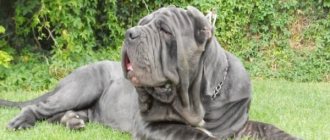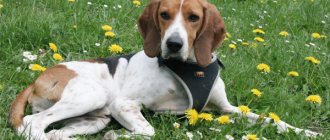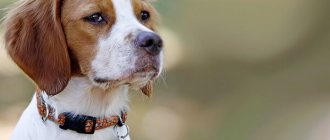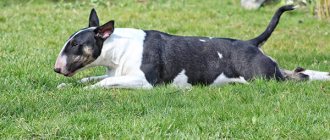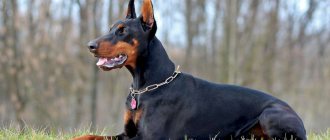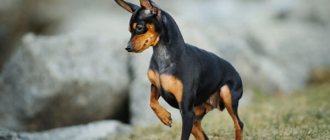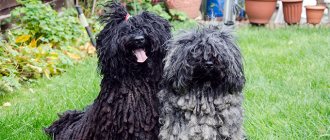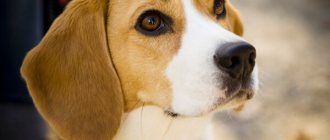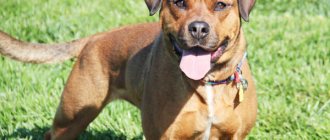Drever (Swedish Dachshund Brakk, Swedish Hound)
Drever (Swedish Dachshund Brakk, Swedish Hound) - detailed description of the dog breed, photos, videos, maintenance features and history of the origin of the breed
Contents:
Photo: Drever (Swedish Dachshund Brakk, Swedish Hound)
Country of origin: Sweden
Group 6: Hounds and related breeds
Section 1: Hounds
Training:
Easy to train.
Color:
tricolor, piebald in various combinations, with the exception of white and liver. White markings visible from all sides are required. Most preferred: White muzzle and collar, as well as white markings on the tip of the tail and paws.
Dimensions:
Height at withers 29-38 cm. Weight about 15 kg.
General impression:
A strong, muscular dog, reminiscent of a dachshund and a beagle.
Usage:
Hunting dog, companion dog. A breed of hunting hounds.
Physical exercise:
To maintain mental health, a dog requires space and plenty of exercise. Drever needs a lot of long walks, he is strong and strong, do not keep him on a leash - he needs active walks and runs. Provide him with a safe place to walk, away from cars and large dogs.
Character:
In everyday life he has a cheerful and even character.
Content:
It is not advisable to keep it in a city apartment.
Grooming:
Simple coat care. You should only comb the fur occasionally with a special brush. Bath only as needed - as little as possible.
Liveability:
In addition to its hunting abilities, the drever has an accommodating and kind disposition, so it easily gets along with any pets. This is a kind and affectionate family dog. An excellent companion, gets along with children, a good watchdog.
Diseases:
Healthy dog.
Diet:
Unpretentious in food.
Lifespan
: about 13 years old.
History of the origin of the breed:
It is believed that at the beginning of the 20th century the breed was obtained by crossing the Westphalian Dachshund Hound with local hound breeds. It is believed that dogs from Denmark also participated in the creation of the breed.
Bred for hunting fox, wild boar, and roe deer. A close relative of the dachshund braque.
In 1947, the breed was officially recognized as an independent breed by the Swedish Kennel Club.
The standard was adopted in Sweden in 1949.
This breed of dog is bred mainly in Scandinavian countries. The breed is little known outside Sweden.
The head is relatively large and long. The transition from forehead to muzzle is pronounced, but weak.
The muzzle is elongated, not pointed.
The eyes are oval shaped. The eyelids are thin. Dark brown color.
The ears are medium in size, wide, with rounded ends, set high, hanging flat on the sides of the head.
The case is strong, stretched format.
The neck is long, fairly strong, without dewlap.
The limbs are muscular, shortened, and set parallel. The feet are strong, with tightly knit, arched toes and dense pads.
The tail is long, thick at the base, saber-shaped. The dog keeps it down.
The coat is dense and straight. On the head, ears, front side of the limbs - relatively short. On the neck, back and back of the thighs - longer.
Drever has excellent sense of smell and stamina. A tireless, brave, agile dog, it has an exceptional sense of smell and a conveying voice.
For the owner, she is a pleasant companion, but she needs an owner with a strong will.
Maintenance and care
This dog, given its small size, can be kept in urban conditions, but this is not advisable; there is nothing better for a dog than life outside the city, in the fresh air.
Price:
Workout
Thanks to his innate intelligence, observation and agility, the drever perfectly perceives everything said and shown to him during training. Training must be done from a very early age and regularly, so you can achieve good results very quickly. Make your dog overcome various obstacles, this will help develop character traits such as courage and endurance. When training a puppy, you need to be doubly careful so as not to in any way cause physical or mental trauma to him, which can leave a serious imprint on the dog’s character. Do not overtire your puppy.
After every 30-50 minutes of training, it is necessary to take twenty-minute breaks, during which let the puppy take a breath, eat or just lie down, basking in the sun. An adult dog does not require any special nutrition. Every day you need to give her one or one and a half times the usual diet. This diet must include fresh meat and fresh vegetables. This set of products will help the tree get all the necessary vitamins for a full life.
If you doubt that you can choose a balanced diet for your pet on your own, then it would be best to contact a specialist who will tell you everything, tell you and advise you. It is worth remembering that if you keep your dog properly, it will live for quite a long time, every day, delighting you with something new.
Thanks to his high mental abilities, observation and agility, the drever can quickly grasp everything and adequately perceive the words of his teacher, remember commands and successfully apply them in practice. This hound should be trained at a tender age. Make your dog overcome various obstacles, then he will be brave and resilient
However, extreme caution must be exercised so as not to cause moral or physical harm to the puppy. Obstacles should not be higher than the dog himself
Every owner is simply obliged to create an exercise plan for their little pet.
Brief historical background
Images of short-legged dogs similar to Swedish hounds can be found in paintings by artists of the Middle Ages. But there are no historical facts confirming their relationship. It is believed that the Drevers were purposefully bred using the backcross method from dachshund hounds (Danish and Westphalian). Beagles also took some part in the formation of the Swedish dachshund breed, since there is a clear visual similarity. The first individuals were registered back in 1913, but the breed became widely known only in the 30s and 40s of the last century.
Buying a dog
If you decide to buy a Drever puppy, be sure to prepare your home for the new family member. Buy toys, equip a sleeping place, a place for feeding and make a list of rules in advance that you would like to follow when having a dog - all this will help to quickly and efficiently adapt the dog. Before making this important decision, you can read reviews and recommendations from owners of similar dogs on various forums. Prices for trees will depend on the pedigree, place of purchase and other factors. Before making a purchase, carefully read all the offers, look at photos, videos, descriptions from breeders, and only then check the prices.
The Drever is a Swedish breed of short-legged hound dog that looks very much like a dachshund. Used for hunting roe deer, hare, fox and other game. They have an excellent sense of smell, viscosity and anger towards the beast, they are hardy and passionate. Poorly suited to be a calm family dog. Another name for the breed: Swedish Dachshund Brack.
Description of the Drever breed
The main purpose of the Swedish dachshund hound is to track deer, roe deer, hares, wild boars and foxes, as well as to expose them to the hunter for a shot. In Scandinavian countries, Drevers are kept as pets and companion dogs.
Appearance
The Drever's physique is squat and elongated with dense, well-developed muscles and strong bones . The body is long and strong with a straight topline, an oval, well-developed chest dropped just below the elbows, a strong, muscular back, well-defined withers (especially in males), a somewhat short but strong loin and a slightly tucked belly. Sexual dimorphism is clearly noticeable; females are significantly smaller than males.
The distance from the ground to the sternum should be approximately 40 percent of the height at the withers.
Extract from the standard
The Drever's build is stocky and elongated.
- Height at the withers: females - 33 cm (acceptable 30–36 cm);
- males - 35 cm (acceptable 32–38 cm).
The Swedish hound moves quickly, elegantly and agilely. He walks with a sweeping and even stride, moving his limbs in parallel, while the top line remains straight.
The straight, hard and coarse coat fits tightly to the body. On the back and neck the hair is slightly longer, and on the hind legs there are small fringes. The hair on the ears, entire head and legs is short. The tail has a short dewlap, like a brush.
The standard allows any colors except solid liver or white. White spots with clear outlines are acceptable. An all-white muzzle, markings on the belly, chest, paws and tip of the tail, and a collar on the neck are preferred. Symmetry is desirable.
According to the standard, it is preferable if the muzzle, chest and neck are white
Disadvantages and disqualifying vices
A defect or minor deficiency is recognized as:
- absence of incisors;
- iris of light shades;
- white spots in areas not specified in the standard;
- flesh-colored nose.
Defects or serious deficiencies will be:
- narrowed lower jaw;
- paws turned outward or inward;
- twisted front legs;
- indirect back (hunchbacked or sagging);
- excessive short stature, stockiness.
The grounds for disqualification are:
- blue iris (both or one);
- incorrect positioning of the fangs on the lower jaw, which can cause dangerous damage to the palate or upper jaw;
- undershot, undershot;
- tail deformation (bend, break, etc.);
- solid white or liver coat color;
- height at the withers that does not correspond to those specified in the standard (both more and less);
- cryptorchidism;
- obvious and clearly visible mental or physical abnormalities;
- cowardice or aggressiveness.
Character and psyche of the breed
The character of the tree is even and calm. The animal is devoid of aggression and nervousness; excessive timidity and shyness are also unusual for it. A brave, energetic and cheerful dog becomes strongly attached to the family in which he lives. In home life, he is flexible, obedient, playful and sociable, but only in case of timely socialization and competent upbringing. These hounds require a firm master's hand, otherwise an overly independent dog will be wayward, disobedient and poorly controlled. The owner must become the unconditional leader and unquestioned authority.
First of all, a drever is a hunter
A small hunting dog becomes an excellent nanny; she happily plays with children and takes an active part in all kinds of games. At first she perceives strangers a little warily, but then her good-natured, hospitable disposition takes over, and she happily runs to meet people and communicate. Other pets, even cats, are treated adequately, but only if they grew up together. The drever evaluates everyone else outside the family circle as uncaught but desired game. An observant, sensitive and intelligent dog has a developed sense of territoriality; the slightest violation of boundaries will be immediately noticed by him.
Character
Drever is not only an excellent hunter, he is a kind, cheerful and devoted companion, an affectionate dog for the whole family. Representatives of this breed get along well with children and love to play with them. They have a calm and balanced character, allowing them to get along peacefully with other dogs and other pets.
The Drever is generally not prone to aggression and is quite predictable; a good indicator of the mood of these dogs is their tail. If a dog wags its tail, it means it is in a great mood. Dredger training must begin from a very early age. They need an owner with a strong character who can become a leader in the relationship with the dog. These dogs are obedient and intelligent; if you approach education with due patience and consistently train the dog, you can achieve good results.
These energetic dogs require plenty of exercise and regular walks, with plenty of room to run around in open spaces. The place for walking should be away from roads and other dangerous places. They can be kept in a city environment, but the best option would be a country house with a large plot next to it.
Owners have absolutely no worries when inviting friends to their home. Drevers are very hospitable and will quickly find a common language with visitors to the house. Their interest and special disposition towards guests will be indicated by a slightly raised and wagging tail. But they are not those who like to be in the very center of events. What they definitely cannot do without is the constant attention of the owner.
If the owner does not devote enough time to training the dog, the animal’s character may deteriorate greatly because of this. He will stop listening to instructions and begin to ignore previously established prohibitions. To prevent this from happening, the owner must secure leadership for himself from the first days the puppy appears in the house and continue to maintain his authority so that the pet feels it. Therefore, you should not ignore any pranks or serious tricks of your pet.
However, you should never use force or raise your voice at a Swiss Hound. This is especially true for training. Even if the dog does not fulfill the tasks assigned to it, in no case should classes be based on rudeness. Only through encouragement, kind words, and through patience and perseverance can positive results be achieved. Therefore, it is better for an experienced dog breeder to purchase a dog breed.
These pets have high security qualities. They are especially valued for their vigilance and sensitivity. During hot periods, it is better for representatives of the breed not to spend a lot of time in the sun, so as not to get heatstroke. In winter, during severe frosts, these creatures should also be protected from drafts and cold.
Choosing a puppy and its cost
It is impossible to buy a Swedish Dachshund Bracket puppy in Russia; in our country this breed is completely unclaimed . However, there are nurseries for breeding trees in the Scandinavian countries (Denmark, Sweden, Norway, Finland, etc.), as well as in Estonia and Lithuania. You should purchase a small pet through specialized hunting clubs, since most breeders are their members. The cost of a purebred puppy starts from 700 euros; adult working dogs are sold for much more.
Visually distinguishing a baby Drevera from other similar breeds (the same beagle) is extremely difficult; it is difficult for an uninitiated person to understand all the nuances. A guarantee of purebred will be the presence of appropriate documents (field diplomas and pedigrees of the parents, puppy card, etc.), as well as a mark in the groin (or ear) of the puppy, which must correspond to the entry in the breed book.
You can only buy a Drever puppy in Scandinavian countries.
Offspring
You can mainly find a pet of this breed in European countries such as Sweden, Finland, Norway, Denmark and Estonia. In other countries they are few in number.
Mating and pregnancy
Boys are bred at 1.5 years of age, and girls at 3rd heat. Earlier mating is not recommended. Over the course of their entire life, they give birth to puppies 3-4 times.
They come into contact with the male once a year. After 6 years, the litter becomes weak, sickly or dead newborns are born. The meeting always takes place on the boy's territory.
Pregnancy lasts from 58 to 70 days. Childbirth can be either premature or delayed. In both cases, this indicates problems with the bitch.
In a healthy female, gestation of the litter and childbirth proceed smoothly without outside interference. Usually they bring 3-5 puppies.
Caring for the tree
It is best to keep Swedish hounds in a private house or country cottage. The pet needs to equip a spacious enclosure or provide it with free access to the yard where it can spend a lot of time. The dog will also adapt to life in a city apartment, but he will need a long daily walk (at least 1.5–2 hours), including various exercises for dexterity and ingenuity. The dog must receive the proper level of physical activity and the opportunity to satisfy all its innate hunting talents, only in this case it will maintain mental and physical health.
There are no difficulties in caring for the tree . The short and smooth coat is brushed daily and combed out every 3-4 days using a special mitten to remove dead hair. Street dogs are bathed very rarely (no more than 1-2 times a year); apartment pets are given water treatments once a month. The eyes and ears are examined every day and cleaned with cotton pads (swabs) with zoo lotion (Bars, Rosinka, etc.). Teeth are brushed once every 7–10 days, using a small brush and animal paste that does not need to be washed off. Claws, if they do not grind down on their own, are shortened once every 3-4 weeks.
The Swedish Hound needs long walks.
You can feed your Swedish Dachshund Bracket with home-cooked, freshly prepared food or dry factory-made formulas intended for active dogs of at least super premium class (Signature Maxi Adulte Energie, Belcando Adult Active, etc.). Some owners prefer a natural diet, which consists of:
- fresh lean meat (horse meat, veal, beef, etc.);
- porridge (rice, buckwheat, oatmeal, etc.);
- fruits, vegetables and fresh herbs;
- fermented milk products with low fat content (cottage cheese, kefir, fermented baked milk, etc.);
- offal (heart, liver, etc.);
- boiled and raw eggs;
- boiled fish (sea).
Vitamin and mineral complexes (Gelakan Fast, Polidex Multivitum Plus, etc.) must be added to natural food. Puppies are fed from 3 to 6 times a day; for adults, two times is enough.
Sweets, flour, fatty, smoked, spicy, peppered, as well as tubular bones and citrus fruits should not be given to dogs.
No matter how many times I asked fellow hunters and dog handlers about the Swedish hound, no one saw her. Those who have been to Scandinavia say that these dogs are very popular and in demand there. Moreover, some owners do not even hunt with them, but simply keep them as family dogs. But the breed has not lost its hunting qualities; field tests are regularly carried out, where all this is confirmed.
Training
Like most hounds, the Drever is quite difficult to train . A well-developed hunting instinct, a certain self-confidence and stubbornness necessary when pursuing game, turn training into a serious test, which only an experienced dog breeder can cope with. Beginners should not mess with this breed.
You need to start training your puppy as early as possible (from 2–2.5 months), an intelligent pet quickly grasps everything and remembers commands well. Classes must be regular and constant.
Drever can participate in sports competitions
It is recommended to take a general obedience course after 5–6 months.
Nutrition
The Drever is a small dog, so it can consume 200-220 g of meat products per day, including beef, chicken, lamb and offal. Fatty pork and other high-fat foods that should not be present in your dog's diet should be avoided. Drever needs a variety of nutrients found in different grains and vegetables, typically oat and wheat.
In the spring and early summer, add finely chopped greens to the dog soup - nettle, sorrel, etc. It makes sense to add synthetic vitamin supplements, which are available in drops or capsules, which can improve the well-being and appearance of the dog's coat.
Drever. Video
The ancestors of the Drever, or Swedish dachshund hound, were two breeds: the Danish dachshund hound and the Westphalian dachshund hound. Perhaps local hounds are also mixed in with it. The result is a strong, well-proportioned dog, distinguished by white markings on the tip of the tail, legs, belly, chest, neck and muzzle.
Dogs have an average height of 29-41 centimeters. They weigh up to fifteen kilograms. Although their limbs are somewhat shortened, they are not curved. The general impression of the dog is stately, compact. This hunting dog breed has a loud voice. A tireless worker with hunting abilities that are beyond all praise, his tail always wags, which indicates his constantly good mood.
In addition to performing hunting duties, Drever is an excellent companion and a good watchman. He is never hot-tempered and is always predictable, for which his owners appreciate him.
Walking, physical activity and rules of safe behavior on the street
The dog needs a long walk. The Italian Bracque feels happy in the lap of nature.
Here he can frolic to his heart's content and satisfy his hunting instincts. City residents who want to get a dog need to be prepared for the fact that the dog will need a daily walk of 2-3 hours, during which it will be able to expend excess physical energy. In urban areas, the dog should be walked in parks or forest belts. The dog can become a companion when jogging and cycling. In public places, the Italian Bracca must be kept on a leash: the hunting nature of the breed can manifest itself in the form of wallowing on the remains of dead animals, chasing cats and birds.
History of the breed
The history of this breed dates back to the Middle Ages. His relative is a dog of the Westphalian Bracket breed, very similar to Drever. His low paws do not allow him to develop great speed, so the hunter could previously follow him on horseback, and now even on foot.
Its homeland is Sweden, where the breed received recognition in 1953. Much time has passed since then, but the breed continues to remain little known outside its country. Exceptions include some Scandinavian countries. Sometimes the dog is used to increase the breeding base of the Westphalian dachshund, the population of which has declined recently.
In relation to the beast, this is a vicious dog that hunts with special passion and excitement. When hunting, Drever is famous for his fearlessness, tirelessness, and perseverance. The agile and courageous dog has an amazing sense of smell. Hunting alone for hares, roe deer, foxes, even wild boars, she is able to cover long distances.
In everyday life, she demonstrates an even and cheerful character. She will be an excellent companion for the owner if he has a strong will. In the “family circle” he becomes kind and affectionate and treats various pets well.
Application
The dog was bred for hunting and copes with its duties perfectly. She can cope not only with a hare and a fox, but also with a wild boar. Having tracked prey, the animal holds it in place until the owner arrives. A dog can also make a wonderful, energetic companion.
In our country, the number of such dogs is constantly decreasing. First of all, this sad fact can be explained very simply. Firstly, Russian people prefer to keep other dogs at home, even those whose dimensions are many times larger than the dimensions of the dog. Secondly, hunting in our country is not so popular, and completely different dogs are used for its needs. Other dog breeds that have the largest numbers in the country are most often considered as companion dogs. Perhaps this situation will soon change and drever will become popular outside of his native Sweden.
Appearance
Drever's head is long and large with a weakly pronounced transition from the forehead to the muzzle. Her muzzle is also elongated with a large nose. Beautiful oval eyes of a dark brown color, and wide, medium-sized ears, set high, hanging down on the sides of the head. The body is of a stretched format with a fairly long neck that does not have a dewlap. The limbs, set parallel, are muscular.
The dog's long saber tail, thick at the base, is always held down. The color of the dense and straight coat is tri-color or piebald in various combinations. The coat is shorter on the ears, head and front of the legs, and longer on the back of the thighs, back and neck.
Content Features
Drever is better suited for living in a private house with the opportunity to spend a lot of time on the site. They adapt relatively easily to life in a city apartment if the owner can provide good physical activity.
The tree has a fairly high need for walks. In appearance, short-legged and clumsy dogs are actually very hardy, energetic, hardworking and maneuverable. They need long walks, exercises for agility and ingenuity, regular training and the opportunity to hunt, which will allow the dog to fully realize their innate talents and maintain physical and mental health.
Care
Drever does not require complex care from the owner. If the dog lives in the house, it is periodically brushed to reduce the amount of hair lost. Street dogs are scratched very rarely or only during seasonal shedding; their ears are periodically examined and cleaned, their eyes are rubbed, and their claws are trimmed. Bath as needed. Apartment no more than once a month using a suitable shampoo.
TemperamentEdit
Drever is an agile, tireless, courageous hound dog with excellent scent and voice. She is cheerful in everyday life and can be a good companion, but due to her independent nature she requires a “steady hand.” Like all hounds, this dog needs exercise and large spaces.
| Dog breeds |
| Australian Short-tailed Cattle Dog • Australian Shepherd • Australian Heeler • Australian Cattle Dog • Australian Kettle • Australian Terrier • Azawakh • Aidi • Alabai • Alano • Alpine Dachshund • American Water Spaniel • English Bulldog • English Coonhound • English Springer Spaniel • Appenzeller Mountain Dog • Affenpinscher • Greater Swiss Mountain Dog • White Swiss Shepherd • Barbet • Bergamasco Shepherd • Bichon Frize • Beauceron • Catahoula Bulldog • Buryat Mongolian Wolfhound • Welsh Corgi • West Highland White Terrier • East European Shepherd • Havanese Bichon • Gampr • Dutch Smoushond • Blue Gascony Basset • Dalmatian • Dandie Dinmont Terrier • Doberman Pinscher • Longhaired Collie • Drathaar • Eurasier • Wire Fox Terrier • Golden Retriever • Irish Water Spaniel • Yorkshire Terrier • Cane Corso • Kerry Blue Terrier • Cairn Terrier • Cromforlander • King Charles Spaniel • Shorthaired Collie • Komondor • Kuvasz • Kurzhaar • Labrador Retriever • Langhaar • Lhasa Apso • Mallorcan Shepherd • Maltese • Miniature Schnauzer • Pug • Moscow Watchdog • German Boxer • Auvergne Pointer • Otterhound • Puggle • Pekingese • Pyrenean Shepherd • Poodle • Puli • Pumi • Samoyed • Saint-Germain Braque • Slovakian Dude • Dachshund • Husky • Hovawart • Croatian Shepherd • Miniature Schnauzer • Chinook • Chihuahua • Swedish Lapphund • Shih Tzu • Sheltie • Sholoitzcuintle • Entlebucher Mountain Dog • Estrela Shepherd • Jagdterrier • Japanese Chin |
Health, illness
Representatives of this young breed are generally characterized by good health. They are characterized by strength and endurance, which helps them work in the strict Scandinavian climate. You just need to keep in mind the tendency of a dog’s drooping ears to become infected and inflamed. Insufficient ventilation of the ear canal contributes to the chronic course of the disease. Therefore, regular examination and timely cleaning of the auricle is the key to the well-being of your pet.
In general, this breed is naturally quite healthy. But a lot depends on the owner. Proper care, as well as a balanced diet, can provide a four-legged creature with a long and rich life. For example, the owner should be extremely attentive to the care products that he chooses for his pet. They must be designed specifically for animals so as not to cause skin allergies, to which trees are susceptible.

